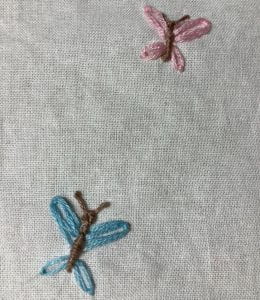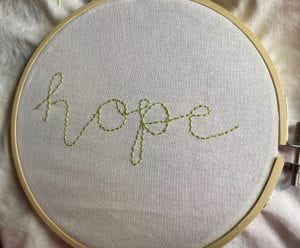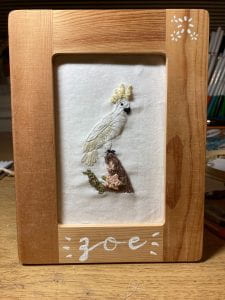According to de Bono in his book How to Have a Beautiful Mind, “Concepts are the parents of practical ideas” (107). They “capture the main ‘essence’ but may not cover all aspects” (118). When defining concepts, it is generally most useful to find a balance between very broad concepts, which may be too vague, and very specific topics, which may “narrow the thinking” (114). Throughout my meetings with my mentor, we have encountered a plethora of concepts. For instance, the concept of embroidery is to add a personal touch of artistic expression to a decorational or practical piece.
Another concept that we frequently touch on is the concept of autonomy. Throughout my in-depth sessions with my mentor, Michelle, I have been given a lot of autonomy. For instance, my mentor gives me the choice to determine approximate dates of our meetings, and I am also able to choose which designs, subjects, or types of designs I am interested in. Furthermore, Michelle repeatedly asks for how I wish to be supported throughout the project, which allows her to help me learn the way I learn best. Most importantly, she always encourages me to bring up any ideas I may have or to show her any projects I am inspired by.
Next, my mentor and I frequently discuss the concept of mentorship and communication. Although the concept of mentorship is to support and encourage people to manage their own learning in order to maximize their potential, develop their skills, improve their performance, and become the person they want to be, while the concept of communication is the act of transferring information, these two ideas have been intertwined in my in-depth experience. Over the past few months of this project, I have found communication to be critical to my mentorship with Michelle. I believe one of the main reasons for the success we have achieved thus far has been our eagerness to communicate in a kind, respectful, and clear manner. By doing so, we can proactively mitigate confusion and misunderstanding.
Lastly, a recurring theme throughout this in-depth project has been the concept of flexibility. This is particularly important during the uncertain and difficult times we have faced as a result of the global pandemic. Essentially, I have learned to adapt my plans while still maintaining my goals, and redefine my paths toward my vision. One of the biggest adjustments I made during the in-depth project was the decision to focus on practicing my stitches with flowers before moving on to larger-scale projects. On a smaller scale, I have modified most of the patterns Michelle has given to me to put a creative twist on the designs and showcase my personal artistic style. However, contrary to popular misinterpretations, flexibility is not the opposite of proper time management. Rather, these two concepts are joined in an interesting way. Only with good time management and a developed knowledge of how much one can accomplish in a certain amount of time can one effectively alter old deadlines and change important details without affecting the overall mission.
With flexibility comes the possibility of alternatives. Throughout this project, my mentor has offered me many alternatives regarding the patterns I hope to use. She would often ask about the direction I wished to take the in-depth project, and gave me a great deal of creative liberty. We often acknowledge that there is not only one path we have to follow. As de Bono states, “The main point is that having a way of doing something does not mean it is the best way of doing it” (125).
At the beginning of the project, Michelle offered alternatives on various supplies I needed. For instance, she offered the alternative of using the medium-sized hoop for my practice projects instead of the smallest hoop, as this would provide more space for me to experiment with the design. She also offered an alternative to the traditional method of threading the needle, which can be difficult, especially when threading multiple pieces of thread into a needle with a smaller eye. By teaching me how to use the needle threader, she streamlined my creative process and added new techniques into my skillset. Moreover, Michelle gave me alternatives to organizing my embroidery thread. Whereas before, I used a single box to store everything, I now use organizational craft boxes and small pieces of cardboard with small slits cut into them to store my thread.
When I mentioned that I wished to use my skills to embroider animals in addition to flowers, Michelle gave me many different choices of simple animal designs to follow, including a rooster, shark, squirrel, flamingo, bee, ladybug, and cockatoo. In the end, I chose to follow the cockatoo pattern. Similarly, my mentor offered me alternatives in terms of possibilities for finished embroidery projects For example, she suggested using my finished embroidery to make cards by pasting them behind a window cut out of cardstock, sew as patches onto tea towels, pillows, or other fabric, or frame them by ironing the edges down to protect and hide hems. In my most recent project, I framed my cockatoo embroidery and added some details and decorations to the frame with a paintbrush.
Although I greatly appreciate the autonomy my mentor has given me and love her mentorship style, it is needless to say that other mentors may have taken a different approach. For instance, another mentor may give me more alternatives through experimentation of various embroidery styles, colour theory (how colours are used together in an appealing manner), different types of embroidery needles, and different types of fabrics. So far, I have only used white 100% cotton fabric, but I would definitely be interested in trying other colours!
Over the past few weeks, I have practiced lettering with the running stitch, embroidered butterflies for the first time, and completed my second large-scale project, which features a cockatoo standing on a stump with vines and flowers, inspired by a simpler pattern my mentor gave me. While completing this last project, I fully appreciated the significance of practice. Although often considered a cliche, the phrase “practice makes perfect” has a certain amount of truth to it. After gaining more experience in embroidering flowers and leaves, I have improved so much. I even experimented with creating a new type of flower that is more three-dimensional, inspired by some of the ones I practiced. This project also offered an opportunity to focus on defining contrasting textures to bring life to my artwork. I gave the feathers more of a long, flowy texture with the lazy daisy stitch, the log an organic, vertical texture with the stem stitch, the vines a looser texture to break away from the solid trunk, and even tried to imitate the natural veins of the leaves. I brought the entire piece and all of these individual elements together with a cohesive colour scheme featuring warm yet earthy and muted tones. Once I finished, I glued the fabric onto a thick piece of cardstock and put it in a wooden frame to give to one of my friends for her birthday.

As the project progresses, I begin to think of exactly how I hope to present my learning once in-depth inevitably ends. I plan to represent my learning to a mixed audience of parents, former TALONS learners, new TALONS learners, and teachers on May 31 during the virtual TALONS in-depth night posted on my blog. As I believe that shorter presentations may keep guests more engaged and give them an opportunity to see the projects of more of my peers, I will create a snapshot of my work through a photo collage with text briefly explaining certain elements of this self-directed learning experience, such as my mentorship, my progress, and my inspiration to pursue this passion. If guests are interested in a more in-depth explanation of my progress, I will also prepare and post an interactive digital journal that they can “flip” through to explain the experience with dates, descriptions of mentorship sessions, photographs of my supplies, various stitches, and each of my projects. Of course, I will also be available to reply to any comments and answer any questions. Throughout the process, I will focus on my progress in my embroidery, comparing my various projects. From my experience, I hope my audience will learn the importance of individual designs.
As I am writing this final blog post, it suddenly hits me how much I will miss this project once it draws to an end. I have thoroughly enjoyed integrating embroidery into my daily routine because it offers me a chance to relax and work on something I love. It is a creative outlet for me to express myself, and, as such, I find it very calming and therapeutic. Moreover, my mentorship with Michelle has been better than I possibly could have imagined. I truly could not have wished for a more supportive, kind teacher! However, just because the in-depth project may end does not mean that I have to stop embroidering. As Michelle has mentioned to me before, and as I have now realized, the skills I have learned from embroidery will accompany me for the rest of my life.



Leave a Reply